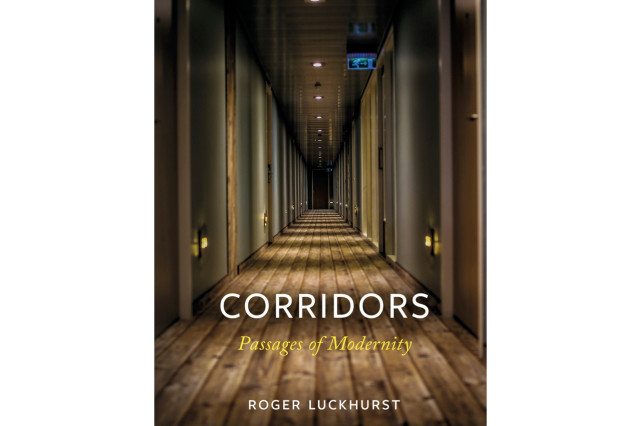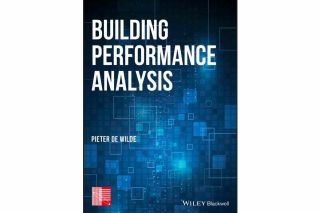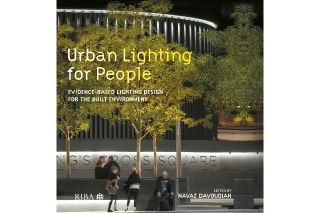
www.buildingsandcities.org/insights/reviews/corridors-passages-of-modernity-review.html
Corridors: Passages of Modernity

By Roger Luckhurst. Reaktion Books, 2019, ISBN: 9781789140538
Sherry MacKay (UBC School of Architecture and Landscape) reviews this book which explores the architectural history of the corridor, and how this essential part of a building has featured in literature, film and TV programmes.
The title, Corridors: Passages of Modernity, conjures
a topic larger than any single, inert architectural element might convey. Corridors in this account is meant to
reference the connective tissue of buildings, neighbourhoods and
infrastructures: grand public colonnades and intimate private passages, arcades
and malls: the interstitial conduits of public and private life. As concrete
spaces that both connect and separate, they are useful tools of categorizing
and distributing, revealing and occluding people and actions. While in the 14th century a
corridor referred to an activity, the running of messengers between places, by
the Enlightenment it meant a space rather than an activity and assumed
different uses and connotations. This is the more straightforward history of
the corridor read through architectural form. But Corridors here is also meant to refer to such spaces in the fictive
as well as the real world.
Luckhurst proposes
to address the general disregard given to the corridor, or corridor-like
spaces, in architectural histories by enlisting the more voluble forms of
cultural history to articulate the, often, mute reality of its architectural
form. This results in a more extended plotting
of the historical development of this one specific, and often overlooked,
spatial typology and a mapping of its appearance across various cultural forms-literature,
film, TV programs and computer games-and the exchanges between them and built
form. In these other media we encounter the uncanny resemblances,
miss-identifications, and metaphoric appropriations of what Luckhurst terms "corridic"
spaces of architecture.
While roughly chronological in development, the narrative is intercut with thematic expositions. The opening chapter, Origins, serves to introduce the corridor etymologically and in its earliest architectural form as well as the pre-corridor world of the Ancient and Medieval Worlds. With this historical expansion is smuggled in transversal pathways, roofed walkways, sacred labyrinths, symbolic paths, domestic peristyles, cloisters and galleries. And so the scene is set for the progression through a number of interlinking thematic explorations: Utopias of public disciplinary and commercial institutions as they evolved across the 19th and 20th centuries: housing, commerce and reform establishments like prisons, asylums and schools; the private house and its expressive use in literature; Dystopia as experienced in bureaucratic corridic spaces in buildings, literature, film and art work and in the corridic spaces evocative of gothic inspired dread and anxiety. The common thread through the essays is that of modernity, from the symbolic world of the ancients, through the institutional spaces of the Enlightenment to the disabling tensions within modernist critique and capitalist development.
This is clear in the book's timeframe and sites of appearance: where the corridor was once "a device for the possibility of social and personal transformation it has now become an anxious and dystopian site" (p. 102). This is the trajectory of modernism infused by the thinking of major 20th century philosophers: Theodor Adorno and Louis Althusser, Walter Benjamin and Michel Foucault, Gaston Bachelard and Roland Barthes, among others. It is a history told in episodes, each with insightful revelations about the corridor, among them: John Vanbrugh's comments on Castle Howard, circa 1700; Samuel van Hoogstraten's painting View of a Corridor, 1662; Sartre's philosophic text Being and Nothingness, 1943; Godard's film Alphaville, 1965; Ann Radcliffe's novel The Mysteries of Udolpho, 1794.
As an
architectural device, the corridor is demonstrated to be intimately connected
to conscious and subconscious desires and fears, expressions and repressions.
It is pragmatic and celebratory, abetting and disabling. The functioning and
significance of the corridor hinges on it being both public and private, open
and closed, fantastic and banal. As spaces they are, as French philosopher Henri
Lefebvre argues, socially constructed and so the corridor in use and in
imagination is compliant with the society that constructs or inherits it.
Corridors and its cognates (labyrinths, galleries, hallways, passages), we are
shown, are not only constructions of desire and illusory ideals, but also harbour
fear and visions of insufficiency in both their afterlife in other media and
the future their remnant forms bequeath. The author proposes that it is only
through an attentive reading, or experience, of the corridor and its mutability
of social, psychic and capital investments that we in fact understand the full
extent of its modernity.
While there have
been at least two architectural studies devoted to the corridor specifically,
they are closely framed by their disciplinary interests. Robin Evans' essay, "Figures,
Doors and Passages" in Translations from
Drawings to Buildings and Other Essays (1997), focused on the appearance of the corridor in 19th
century English domestic architecture as the harbinger of a more private and
segregated life, one that was less social and less sensual. Mark Jarzombek 's "Corridor Spaces" in Critical Inquiry (2010) was a rebuttal
of Evans' attribution of a privatizing function to the corridor, arguing that it
was in fact a space of public life with a socially defined meaning as
demonstrated in its specific etymology and provenance. If Evans does reference
the wider cultural milieu of literature and painting to make his point, it is
an architectural audience he addresses, as does Jarzombek. And while Thomas
Markus's Buildings and Power (1993)
comes to mind as a similarly Foucauldian history of the same Enlightenment
institutional buildings as explored In Corridors:
Passages of Modernity, the corridor is only occasionally marked on plans
and it is the disciplinary roles and social relations that such connecting
spaces perform in regimenting bodies and minds and empowering reason and enforcers
that is his focus.
Luckhurst's complimentary
cultural histories complicate his fairly orderly architectural chronology with
temporal misalignments; cultural expressions sometimes co-exist, occasionally
circle back, or alternatively project forward the corridor's affect. However, they
also offer a more inclusive understanding of the corridor than following a
strictly architectural nomenclature or history with its careful parsing of the
differences between a corridor or passage, for example, might allow. Although, bereft
of these fine gradations something of the distinctions of class and purpose
that such terminology upheld is lost. Luckhurst
greatly amplifies the insights of these earlier accounts, providing a more
comprehensive, if more diffuse, history. In doing so he expands our cultural
understanding of the psychic power and uncanny aspects bequeathed and inspired
by corridic spaces.
But what makes
these corridors Passages of Modernity?
Why is the corridor, as the author declares in his introduction, "that
quintessentially modern space"? (p. 7). Modernity refers to the experience of
modernizing forces, the replacement of tradition, religion and myth with changeable
codes, science and reason; it is a consciousness of what Charles Baudelaire
termed, in his 1863 The Painters of
Modern Life, "the ephemeral, the fugitive, the contingent" and with it the
sense of a void, an absence, and the unknown (p. 13). In The
Condition of Postmodernity (1990), cultural geographer David Harvey proposes
that there is a dilemma at the heart of modernist aesthetic responses to
modernity: on the one hand there is the "flux and change, ephemerality and
fragmentation of the material bases of modern life" and on the other the quest
for some claim to the eternal and immutable" (p. 20). The corridor as "quintessentially
a modern space" seems to encapsulate this tension between progress and some
kind of stability in the instability of the modern world. Hence the fear of the
dehumanizing process embedded in the improving impulses of
institutionalization, the waning fashionableness of the Astoria Hotel's Peacock
Alley, the failure of the 'streets in the air' of post-war social housing
schemes, or the potency of the angst-ridden corridor in films such as Stanley Kubrick's The Shining (1980) or Alain Resnais' Last Year at Marienbad (1961).
While the
profligate or disciplined liaisons of architectural (and urban) spaces and
their imaginaries in literature, film and video games offer insight on the
potent cultural force of architectural corridic space, what is also relevant is
the attention Corridors: Passages of
Modernity gives to infrastructure and its molding of not only actions but
also thought. Although we are, the author claims, living in an "anti-corridic
world" where the corridor is reduced to a repressed existence in open plan
offices or infrastructure, it is still a potent feature of our built and
imagined world, a part of both lived and psychic space. Corridic space influences
not only culture but also the substrata of productive, political and economic
life. And while the corridor as
enlightenment device may be as passé as the modernity it facilitated, as
quintessentially modern, corridic space would necessarily be transitory,
superseded. As infrastructure, however, it can perhaps offer some insight into
our present-day conduits of post-modernity.
In his
introduction, Luckhurst concludes that "corridors are now regarded as
infrastructure, the underpinning service elements of the world that are too
big, or buried, or boring, to deserve comment. Quoting Marc Angélil and Cary Siress in Infrastructure Space (2017), Luckhurst
remarks, infrastructure "seldom sustains mindful attention, manifesting instead
the stuff of an unremarked substrate simply serving the basics of everyday life"
(p.10). It has become un-architecture he concludes. The architectural corridor, with its role of "protecting
or remaking social habits, cultural values, economies and technology" while
harbouring fears, anxieties and the unknown, is superseded by new information
and electronic technologies with their specific codes and protocols. Now, as he suggests, when we pass through these
architectural corridic spaces, we experience merely an afterglow, like Walter Benjamin's
Paris Arcades, they seem to be mementos of a past social order. Corridors: Passages of Modernity
demonstrates that the, often overlooked, corridor, uncelebrated by
architectural history, was in fact a social, political, economic as well as
aesthetic matter which should encourage us to look at our current
infrastructure with equal discernment.
Sherry McKay is an architectural historian and as of 2019 Professor Emerita of the UBC School of Architecture and Landscape (SALA) and College Unit Representative of the Emeritus College. She was the recipient of a Killam Teaching Award and inaugural Chair of the architecture program in SALA (2006-09). Her research on west coast architecture and French architecture of the modern colonial era appears in North American and French publications, including books, chapters and essays.
References
Angélil, M. and Siress, C. (2017) Infrastructure Takes Command: Coming out of the Background. In: Infrastructure Space. [eds. Ilka and Andreas Ruby], 11-23. Berlin: Ruby Press.
Baudelaire, C. (1863/ 1964) The Painters of Modern Life. [Translated and
edited by Jonathan Mayne] London: Phaidon Press.
Evans, R .(1997)
Figures, Doors and Passages. Translations
from Drawings to Buildings and Other Essays. Cambridge, MA: MIT Press.
Harvey, D. (1990) The Conditions of Post Modernity. Malden
MA and Oxford UK: Blackwell.
Jarzombek, M. (2010) Corridor Spaces. Critical Inquiry 36, 728-770.
Markus, T. (1993) Buildings and Power. London and
New York: Routledge.
Latest Peer-Reviewed Journal Content
Designing for pro-environmental behaviour change: the aspiration–reality gap
J Simpson & J Uttley
Lifetimes of demolished buildings in US and European cities
J Berglund-Brown, I Dobie, J Hewitt, C De Wolf & J Ochsendorf
Expanding the framework of urban living labs using grassroots methods
T Ahmed, I Delsante & L Migliavacca
Youth engagement in urban living labs: tools, methods and pedagogies
N Charalambous, C Panayi, C Mady, T Augustinčić & D Berc
Co-creating urban transformation: a stakeholder analysis for Germany’s heat transition
P Heger, C Bieber, M Hendawy & A Shooshtari
Placemaking living lab: creating resilient social and spatial infrastructures
M Dodd, N Madabhushi & R Lees
Church pipe organs: historical tuning records as indoor environmental evidence
B Bingley, A Knight & Y Xing
A framework for 1.5°C-aligned GHG budgets in architecture
G Betti, I Spaar, D Bachmann, A Jerosch-Herold, E Kühner, R Yang, K Avhad & S Sinning
Net zero retrofit of the building stock [editorial]
D Godoy-Shimizu & P Steadman
Co-learning in living labs: nurturing civic agency and resilience
A Belfield
The importance of multi-roles and code-switching in living labs
H Noller & A Tarik
Researchers’ shifting roles in living labs for knowledge co-production
C-C Dobre & G Faldi
Increasing civic resilience in urban living labs: city authorities’ roles
E Alatalo, M Laine & M Kyrönviita
Co-curation as civic practice in community engagement
Z Li, M Sunikka-Blank, R Purohit & F Samuel
Preserving buildings: emission reductions from circular economy strategies in Austria
N Alaux, V Kulmer, J Vogel & A Passer
Urban living labs: relationality between institutions and local circularity
P Palo, M Adelfio, J Lundin & E Brandão
Living labs: epistemic modelling, temporariness and land value
J Clossick, T Khonsari & U Steven
Co-creating interventions to prevent mosquito-borne disease transmission in hospitals
O Sloan Wood, E Lupenza, D M Agnello, J B Knudsen, M Msellem, K L Schiøler & F Saleh
Circularity at the neighbourhood scale: co-creative living lab lessons
J Honsa, A Versele, T Van de Kerckhove & C Piccardo
Positive energy districts and energy communities: how living labs create value
E Malakhatka, O Shafqat, A Sandoff & L Thuvander
Built environment governance and professionalism: the end of laissez-faire (again)
S Foxell
Co-creating justice in housing energy transitions through energy living labs
D Ricci, C Leiwakabessy, S van Wieringen, P de Koning & T Konstantinou
HVAC characterisation of existing Canadian buildings for decarbonisation retrofit identification
J Adebisi & J J McArthur
Simulation and the building performance gap [editorial]
M Donn
Developing criteria for effective building-sector commitments in nationally determined contributions
P Graham, K McFarlane & M Taheri
Join Our Community

The most important part of any journal is our people – readers, authors, reviewers, editorial board members and editors. You are cordially invited to join our community by joining our mailing list. We send out occasional emails about the journal – calls for papers, special issues, events and more.
We will not share your email with third parties. Read more



Latest Commentaries
COP30 Report
Matti Kuittinen (Aalto University) reflects on his experience of attending the 2025 UN Conference of the Parties in Belém, Brazil. The roadmaps and commitments failed to deliver the objectives of the 2025 Paris Agreement. However, 2 countries - Japan and Senegal - announced they are creating roadmaps to decarbonise their buildings. An international group of government ministers put housing on the agenda - specifying the need for reduced carbon and energy use along with affordability, quality and climate resilience.
Building-Related Research: New Context, New Challenges
Raymond J. Cole (University of British Columbia) reflects on the key challenges raised in the 34 commissioned essays for Buildings & Cities 5th anniversary. Not only are key research issues identified, but the consequences of changing contexts for conducting research and tailoring its influence on society are highlighted as key areas of action.